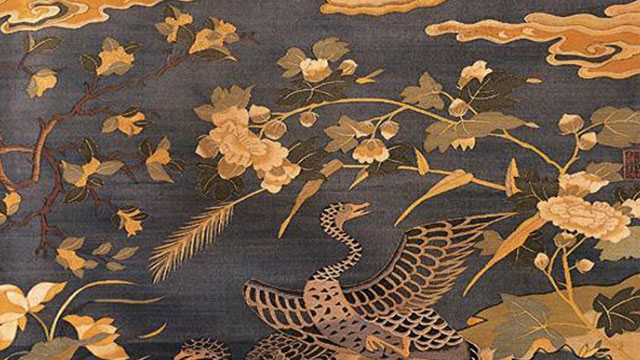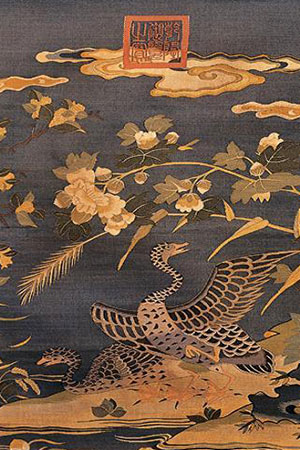Zhu Kerou
Zhu Kerou was a craftsman of Kesi in Song Dynasty. Ming Qiang, Zi Gang, was born in Huating county (now Songjiang, Shanghai) during the years of song Xuanhe and Shaoxing.
Zhu Kerou Wiki:
| Chinese name | Zhu Kerou |
| Foreign name | ZhuKerou |
| alias | Zhu Gang |
| nationality | China |
| nation | Chinese |
| birthplace | Huating County |
| occupation | Craftsman |

Chinese PinYin : Zhu Ke Rou
Zhu Kerou, the year of birth and death is unknown. Children learn painting and Kesi (also known as silk carving),
Accumulate experience in color matching and line transportation. She and Shen Zifan in Dingzhou are equally famous Kesi artists in the Song Dynasty. From Huizong to Gaozong of Song Dynasty, it was famous for weaving Kesi and was good at painting. Her Kesi works have a wide range of themes, including figures, trees, stones, flowers and birds, with light and elegant style and vivid image, which is a unique skill for a time. Collectors regard their works as famous paintings. Some works, such as peony, camellia, lotus pond suckling duck, peach blossom thrush, babbler and red Polygonum, have been handed down to this day, which are both picturesque and profound decorative interest. At that time, the production center of Kesi was "Dingzhou in the north and Songjiang in the South". Zhu was an outstanding representative of Songjiang.
It was mainly active in the Gaozong period of the Southern Song Dynasty. It was famous for Kesi nvhong. At the same time, it was also good at painting
It has a certain influence on her Kesi creation.
In addition to flowers, feathers and other patterns, Zhu Kerou's works also have a lot of famous people's calligraphy and painting imitating the Ke, which are of high quality and high quality. They were deeply loved by people at that time, and became a precious handicraft that literati celebrities scrambled to buy at that time.
She created Kesi with exquisite flowers, birds and characters. The silk is like a pen. The color is clever, ancient and elegant. It is a unique skill of the time. Thus, the Kesi developed from pure practicability to decoration, and became an independent work of art.
Her Kesi works have a wide range of themes, including figures, trees, stones, flowers and birds, with light and elegant style and vivid image, which is a unique skill for a time. Collectors regard their works as famous paintings.
His handed down works of Kesi include the painting of lotus pond milk duck (Shanghai Museum), camellia and Peony (all collected in Liaoning Museum (see the color picture of Kesi Peony (song)). With fine Kesi work, elegant style and vivid form and spirit, it is the boutique of Kesi in the Southern Song Dynasty. These boutiques are both picturesque and deeply decorative.
Zhu Kerou, female, was a famous Kesi artist and painter in Gaozong of the Southern Song Dynasty. Name is just, word is soft. Yunjian in the Southern Song Dynasty (today's Songjiang County, Shanghai) was born. Birth and death are unknown. His family is poor. He studied Kesi since childhood and is famous for Kesi needlework.
The surface of the Kesi woven by Zhu Kerou is compact and plump, the silk strands are symmetrical and brilliant, the color matching of the picture is varied, the layers are clear and coordinated, and the three-dimensional effect is excellent. Some are similar to carving and inlay. Her characters, trees, stones, flowers and birds are very fine, harmonious, fresh and beautiful. Later collectors Zhen Tong famous paintings. Even the emperor of the Song Dynasty sent eunuchs to search the south of the Yangtze River.
Song Huizong also wrote a poem on a "picture of green peach, butterfly and Sparrow": "a sparrow steps on a flower branch to make a beautiful flower. He once heard that it is difficult to carve (carve) silk. He knew that it should be Xuanhe things, not ordinary embroidery."
In the Qing Dynasty, the official had a collection of thread paintings, which opened 20 times. See Mo Yuan Hui Guan and Shi Qu Bao Ji.
In an Yi Zhou's famous painting "ink edge collection view", Wen Yan can inscribe: "Zhu Kerou walks the world with needlework. Figures, trees, stones, flowers and birds are exquisite, suspicious of ghosts, and the price of products is high. It has been spread for a while, especially rare today. Once this ruler frame was simple and elegant, and there were various famous artists who won the country. The charm washed away the fat and powder until it was transported like a pen. It is a unique skill, which is not what people dream of today. It should be treasure."
"Lotus pond suckling duck" (collected by Shanghai Museum), "mountain tea" and "Peony" (collected by Liaoning Museum) are Zhu Kerou's handed down treasures.
"Zhu Ke" is known as the peak of Chinese Kesi technology, and its works became the rush of bureaucrats and scholars at that time. In Zhu Qiqian's notes on silk embroidery, it is said that "exquisite ghost work is suspected, and the price of the product is high for a time." Zhu Kerou's tapestry works are included in the collection of ink images · famous paintings by an Yi Zhou of the Qing Dynasty, and Wen Yan can inscribe: "Zhu Kerou walks the world with needlework,... This ruler frame is ancient and elegant,... Until its silk is like a pen, which is a unique skill, which is not what people dream of today. It should be treasured."
One of Zhu Kerou's handed down works, the painting of milk ducks in Liantang, is skillful in making and successful in business. Another Kesi work, the painting of Camellia nymphalus and peony, is on magnetic cyan silk. Three Camellia in full bloom and a flying nymphalus are woven with colorful weft Kesi, which are the best works of Kesi painting in the Song Dynasty. Today, Shanghai Museum and Liaoning museum have their handed down works.
The painting of suckling ducks in Liantang is 107.5cm long and 108.8cm wide. The picture is lively and colorful. Red leaf egrets, green duckweeds, kingfishers, dragonflies, grass insects and double ducks play. Egrets look like elves, one female and one male. Double ducks swim leisurely. The small section of official script "made by Zhu Gang in Jiangdong and the picture of milk duck in Liantang" is taped on Qingshi. There is a vermilion seal of "Kerou" in the lower left corner of the picture. This piece of silk tapestry has a large width, tight organization, fine weaving, symmetrical strands, clear layers, skillful production and mixed business. It can be said to be superb. Works of Zhu Kerou, a famous Kesi artist.
The painting of Camellia nymphalus butterfly is a handed down work of Zhu Kerou, a famous Kesi artist in the Southern Song Dynasty. It is now collected in the Liaoning Provincial Museum. The original is 25.6cm high and 25.3cm wide. On the magnetic cyan ground, three Camellias in full bloom and a pair of flying nymphalus butterflies are woven with colorful weft tapestries. Use Qi Kefa to weave the branches and green leaves, as well as the stamens and petals of Camellia in full bloom; The butterfly wings are fainted by the method of robbing the tapestry, and the butterfly must be supplemented by the tapestry. The three buds on the branches are budding, and the yellow leaves eaten by insects are vivid and lifelike. In the lower left corner, there is a frame of "Zhu Yin" woven by Zhu Kerou.

Zhu Kerou
